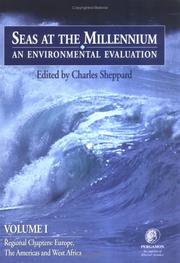| Listing 1 - 3 of 3 |
Sort by
|

ISBN: 0080432077 9780080432076 Year: 2000 Publisher: Amsterdam: Pergamon,
Abstract | Keywords | Export | Availability | Bookmark
 Loading...
Loading...Choose an application
- Reference Manager
- EndNote
- RefWorks (Direct export to RefWorks)
This valuable work, published in September 2000, provides a comprehensive review of the environmental condition of the seas of the world, sea by sea and region by region. It focuses on all aspects of man's interactions with the seas and with their biological and physical systems. The three volumes of Seas at the Millennium: an Environmental Evaluation cover issues of global and regional importance such as: biological description of the coast and continental shelf waters; development and use of the coast; landfill and its effects; pollutant discharges over time; effects of over-fishing; management methods and techniques used to ensure continued ecosystem functioning. The relative importance of water-borne and airborne routes differ in different parts of the world, so routes and paths of pollutant movement in different areas will be examined and described in their local and global context. Each chapter is written by experts in the field. The regional chapters include: an historical overview of the area concerned in environmental terms; uses to which it has been put and to which it is put today; its current environmental status and major problems arising from human use of both the sea and its watershed; informed comment on major trends, problems and successes; and recommendations for the future. The global issues chapters cover major habitats and species groups, governmental, education and legal issues, fisheries effects, remote sensing, climate change and management.
Marine ecology. --- Ecologie marine --- Climate --- Fisheries. --- Aquaculture --- Mer --- Climate. --- Coral reef --- Remote sensing --- Seawater pollution
Book
ISBN: 9780198869825 0198869827 Year: 2021 Volume: 391 Publisher: Oxford: Oxford university press,
Abstract | Keywords | Export | Availability | Bookmark
 Loading...
Loading...Choose an application
- Reference Manager
- EndNote
- RefWorks (Direct export to RefWorks)
Coral reefs are among the most beautiful, and most diverse, of ecosystems. Early seafarers were wary of them, naturalists were confused by them, yet many coastal people benefited greatly from these mysterious rocky structures that grew up to the surface of the sea. They have been rich in their supply of food, and they provided a breakwater from storms and high waves to countless coastal communities that developed from their protection. Their scale is enormous and their value high. Found in countless locations around the world, from the Indo-Pacific coral reef province to the Caribbean and Australia, they support both marine and human life.But today coral reefs are in trouble, with many dying or suffering from over-exploitation, pollution, and the warming and acidification of the oceans. Understanding reefs, their conservation and management, is vital, and so is conveying this to authority if we are to preserve these remarkable ecosystems. In this Very Short Introduction Charles Sheppard describes the complex structure and interdependencies of a reef, how reefs have evolved, the diversity of marine life that they support, and their importance to the human population who live beside them. This new edition describes the latest research on the complex symbioses of coral animals with microorganisms. It also highlights the scale of the challenge facing our reefs today, following recent ocean heatwaves - part of wider climate disruption - that killed half the world's reefs, and considers what can be done to preserve these essential and vibrant ecosystems.
Book
ISBN: 9780198787341 0198787340 9780198787358 0198787359 Year: 2019 Publisher: Oxford: Oxford university press,
Abstract | Keywords | Export | Availability | Bookmark
 Loading...
Loading...Choose an application
- Reference Manager
- EndNote
- RefWorks (Direct export to RefWorks)
Coral reef biology --- Coral reef ecology --- Coral reef conservation --- Coral reef biology. --- Coral reef ecology. --- Coral reef conservation. --- Marine biology --- Biologie des récifs coralliens. --- Écologie des récifs coralliens. --- Biologie marine. --- Récifs coralliens --- Conservation. --- Biologie des récifs coralliens. --- Écologie des récifs coralliens. --- Récifs coralliens
| Listing 1 - 3 of 3 |
Sort by
|

 Search
Search Feedback
Feedback About UniCat
About UniCat  Help
Help News
News